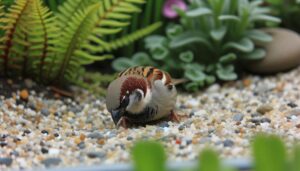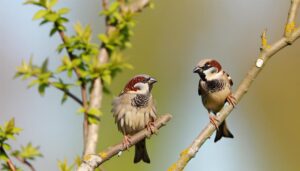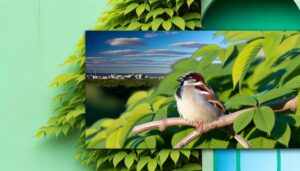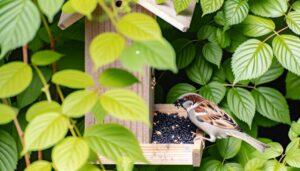7 Steps to Draw a House Sparrow: A Beginner’s Guide
To draw a house sparrow, start by gathering high-quality graphite pencils, a kneaded eraser, blending tools, and suitable drawing paper. Understand its anatomy: a short, conical beak, rounded head, compact body, short wings, squared tail, and slender legs.
Begin with basic shapes such as an oval for the body and triangles for wings. Refine these shapes, ensuring accurate proportions.
Sketch primary, secondary, and tertial feathers for the wings, and render the tail with rectrices in a fan-out pattern. Draw the beak with a slight curve and position the eyes with a prominent pupil.
Shade using varying tones for depth and realism. Continue to uncover more detailed techniques and tips.
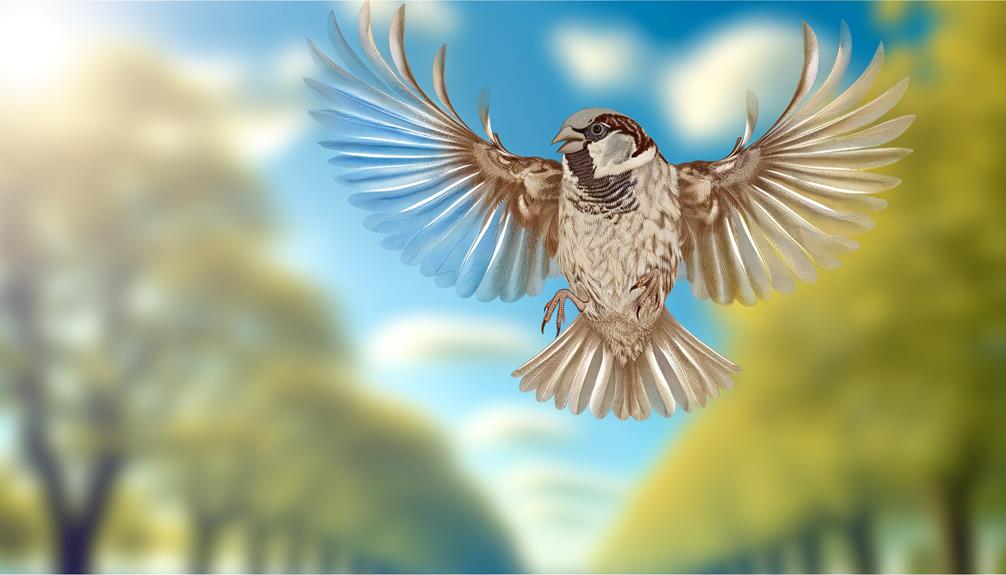
Key Takeaways
- Start with basic shapes like an oval for the body and a triangle for the wings to establish proportions.
- Sketch the rounded head, conical beak, and position the eyes with a prominent pupil.
- Refine the body, connect the head with the neck, and add short, rounded wings and squared tail.
- Detail the primary and secondary feathers on the wings and the symmetrical fan-out rectrices on the tail.
- Use shading techniques like crosshatching and feathered strokes to add depth and realism to the plumage.
Gather Your Drawing Materials
To begin drawing a house sparrow, it is important to gather all necessary drawing materials, including high-quality graphite pencils, erasers, a sharpener, blending tools, and suitable drawing paper. Graphite pencils of varying hardness, from H to B grades, allow for the creation of diverse textures and tones.
A kneaded eraser is vital for lifting graphite without damaging the paper, while a precision eraser helps in detailing. A good sharpener maintains pencil points for intricate work. Blending tools, such as tortillons or blending stumps, aid in achieving smooth gradients and realistic feather textures.
Study the House Sparrow's Anatomy
Understanding the house sparrow's anatomy involves studying its distinctive features. Such as the short, conical beak, rounded head, and compact body structure. The beak, designed for seed eating, is robust and tapers to a point.
The head, proportionally larger relative to the body, is smoothly rounded and merges seamlessly into the neck. The body is stout, enhancing the bird's agility and quick flight capabilities. Importantly, the wings are short and rounded, contributing to their swift, fluttering flight.
The tail is relatively short and squared off at the end. The legs are slender yet sturdy, adapted for perching and hopping. Observing these characteristics closely will provide a solid foundation for accurately capturing the essence of the house sparrow in your drawings.
Sketch the Basic Shapes
To begin sketching the basic shapes of a house sparrow, start with an oval to represent the body, ensuring it captures the bird's compact and rounded form.
Next, add a triangle extending from the upper part of the oval for the wings, paying attention to their proportional length and placement.
Outline the Body
Begin by sketching an oval shape for the body, ensuring it is slightly elongated to capture the natural proportions of a house sparrow. This shape serves as the foundational structure, accurately reflecting the bird's compact yet robust physique.
Position the oval at a slight angle to mimic the typical posture of a sparrow. Next, add a small circle at the top for the head, making sure it is proportionate to the body. Connect the head and body with tapering lines to form the neck.
To delineate the tail, extend a short, narrow triangle from the lower end of the body oval. This basic outline sets the stage for more intricate detailing, ensuring anatomical accuracy and a lifelike representation.
Draw the Wings
Position the wings by sketching an elongated, curved shape that extends from the upper part of the body oval, confirming they sit naturally along the sides of the sparrow's body. This initial shape should mirror the gentle arc of a sparrow's wings when at rest, tapering slightly towards the tips.
Pay attention to the anatomical structure, where the wings begin close to the shoulder region and flow smoothly downward. The primary flight feathers should be indicated by subtle lines diverging from the main wing shape, capturing the layered texture.
Verify the wings' curvature and angle align with the bird's natural posture, maintaining proportionality to the body size. This foundational sketch will guide the detailed feathering in subsequent steps.
Shape the Head
Start by sketching a small, rounded shape above the body, representing the sparrow's head, making sure it is proportionate to the bird's overall size and aligned with the neck region. This foundational shape will serve as the basis for adding detailed features later. Pay close attention to the size and placement, as an accurately proportioned head is critical for a realistic depiction.
| Feature | Description | Notes |
|---|---|---|
| Shape | Rounded, petite | Proportionate to body size |
| Placement | Above the neck region | Aligned centrally with the body |
| Proportion | Relative to overall bird size | Ensures anatomical accuracy |
Outline the Sparrow's Body
To outline the sparrow's body, begin by refining the basic body shape, ensuring it captures the characteristic compact and rounded form of the bird.
Pay close attention to the placement of the wings and tail, aligning them anatomically with the bird's natural posture.
Maintain proper proportion and symmetry throughout, as these elements are essential for achieving an accurate and lifelike representation.
Basic Body Shape
Begin by sketching an oval for the sparrow's body, ensuring it is proportionally accurate to the bird's actual size and form. This oval will serve as the foundational shape, representing the core mass of the sparrow. Position it slightly tilted, with a minor elongation towards the tail end, to capture the natural posture.
Next, add a smaller circle at the top of the oval for the head, ensuring it overlaps slightly. The head should be roughly one-third the size of the body. Pay attention to the alignment; the head should seamlessly flow into the body.
Lastly, lightly sketch the neck, connecting the head and body, ensuring smooth progressions and maintaining anatomical accuracy.
Wing and Tail Placement
Carefully delineate the primary wing shape by sketching an elongated, curved form extending from the upper side of the body oval, ensuring it tapers towards the tip to reflect the natural aerodynamic structure.
Position the wing slightly below the midpoint of the sparrow's body to maintain anatomical accuracy.
Next, outline the tail feathers by drawing a series of straight, slightly diverging lines originating from the lower end of the body oval. The tail should fan out subtly and extend beyond the body, providing balance and stability.
Pay attention to the proportional length of the tail relative to the body, as it is essential for an authentic representation. Both wing and tail placement greatly influence the bird's overall posture and realism.
Proportion and Symmetry
With the wing and tail accurately positioned, the next step involves outlining the sparrow's body to secure proper proportion and symmetry. Begin by sketching the central oval shape representing the torso, confirming it is neither too elongated nor too compressed. This serves as the foundation for the bird's anatomical accuracy.
- Head Placement: Align the head with the torso, maintaining a balanced proportion.
- Neck Connection: Smoothly connect the head to the body, adding gentle curves to represent feathers.
- Leg Position: Draw the legs slightly forward from the center of the body for a natural stance.
- Breast Contour: Outline the breast with a gentle curve, extending slightly outward to reflect the sparrow's plump appearance.
Using these guidelines secures a harmonious and realistic portrayal of the house sparrow.
Add Wing and Tail Details
To accurately depict the wing and tail details of a house sparrow, focus on rendering the primary and secondary feathers with meticulous attention to their layered arrangement and varying lengths.
The primary feathers, or remiges, are longer and more robust, essential for flight, and should be depicted with a slight curvature.
The secondary feathers are shorter and contribute to the bird's lift and maneuverability. The tertial feathers, located closer to the body, provide additional coverage.
For the tail, illustrate the rectrices, which fan out symmetrically and taper slightly towards the ends. Pay attention to the subtle differences in feather lengths and the gentle gradation from the base to the tip, ensuring anatomical accuracy and lifelike representation.
Draw the Facial Features
The facial features of a house sparrow require precise attention to the beak, eyes, and distinctive markings to ensure an anatomically accurate portrayal. Begin by sketching the short, conical beak, ensuring it has a slight curve at the tip.
Next, position the eyes correctly by noting their relative size and placement. Make sure to:
- Draw a small, round eye with a prominent pupil.
- Add a light reflection spot for a lifelike appearance.
- Illustrate the dark feather markings extending from the beak base through the eye.
- Detail the subtle patterning around the cheeks and neck.
These features are essential to capture the character and authenticity of the house sparrow. Accurate attention to these elements will elevate the overall quality of your drawing.
Shade and Add Final Touches
Shading the house sparrow involves careful attention to the varying tones of its plumage to create depth and realism. Begin with softer shades for the lighter areas, such as the underbelly and the lower wing feathers. Gradually apply more pressure to darken the upper parts, like the head and the back, where shadows naturally fall.
| Area | Light Source | Shading Technique |
|---|---|---|
| Head | Top | Crosshatching |
| Back | Above | Layered shading |
| Wings | Side | Feathered strokes |
| Underbelly | Bottom | Light blending |
| Tail Feathers | Rear | Gradual darkening |
Conclusion
Mastering the art of drawing a house sparrow requires meticulous attention to anatomical details and an understanding of avian structure.
Just as a watchmaker intricately assembles each component to create a precise timepiece, an artist must carefully construct each element of the sparrow—from the basic shapes to the nuanced shading.
This disciplined approach not only enhances drawing skills but also fosters a deeper appreciation for the complexity and beauty of the natural world.


